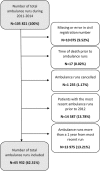Repeated ambulance use is associated with chronic diseases - a population-based historic cohort study of patients' symptoms and diagnoses
- PMID: 30992042
- PMCID: PMC6469091
- DOI: 10.1186/s13049-019-0624-4
Repeated ambulance use is associated with chronic diseases - a population-based historic cohort study of patients' symptoms and diagnoses
Abstract
Background: There is a growing demand for emergency medical services (EMS) and patients are repeatedly transported by ambulance services. For many patients, especially those with chronic disease, there may be better ways of delivering care. We examined the symptom at time of emergency call and the hospital diagnosis for those ambulance users who repeatedly received an ambulance.
Methods: Population-based historic cohort study of patients receiving an ambulance after an emergency call between 2011 and 2014: one-time users (i.e. one ambulance run in any 12 month period) were compared to two-time users (two runs in any 12 month period) and frequent users (>two runs). The presenting symptom according to the Danish Index for Emergency Care from the EMS calls and the hospital ICD-10 discharge diagnoses were obtained from patient records.
Results: We included 52 533 patients (65 932 emergency ambulance runs). Repeated users constituted 16% of the patients (two-time users 11% and frequent users 5%) and one third of all ambulance runs. The symptoms showing the largest increase in frequency with increasing ambulance use were breathing difficulty (N = 3 905-15% were frequent users); seizure (N = 2 437-10% were frequent users), chest pain (N = 7 616-17% were frequent users), and alcohol intoxication (N = 1 998-5% were frequent users). The hospital diagnoses with a corresponding increase were respiratory diseases (N = 4 381) - 13% were frequent users), mental disorders (predominately abuse of alcohol) (N = 3 087-10% were frequent users) and neurological diseases (predominately epilepsy) (N = 2 207-6% were frequent users). 5% of one-time users, 12% of two-time users and 16% of frequent users had a Charlson Comorbidity Index > = 3.
Conclusion: Repeated use of ambulance services was common and associated with chronic health problems such as chronic respiratory diseases, epilepsy, mental disorders with alcohol abuse and comorbidity. Alternative methods of caring for many of these patients should be considered.
Trial registration: None.
Keywords: Ambulance; Denmark; Diagnoses; Emergency call; Emergency medical services; Frequent users; Repeated users.
Conflict of interest statement
Ethics approval and consent to participate
The study was approved by the Danish Data Protection Agency (North Denmark Region record number 2008-58-0028) and project identification number 2016–80 and by the Danish Patient Safety Authority (record number 3–3013-1675/1/).
Consent for publication
Not applicable.
Competing interests
The authors declare that they have no competing interests.
Publisher’s Note
Springer Nature remains neutral with regard to jurisdictional claims in published maps and institutional affiliations.
Figures





References
-
- Christensen EF, Bendtsen MD, Larsen TM, Jensen FB, Lindskou TA, Holdgaard HO, et al. Trends in diagnostic patterns and mortality in emergency ambulance service patients in 2007−2014: a population-based cohort study from the North Denmark region. BMJ Open. 2017;7(8):e014508. doi: 10.1136/bmjopen-2016-014508. - DOI - PMC - PubMed
Publication types
MeSH terms
LinkOut - more resources
Full Text Sources
Medical
Miscellaneous

